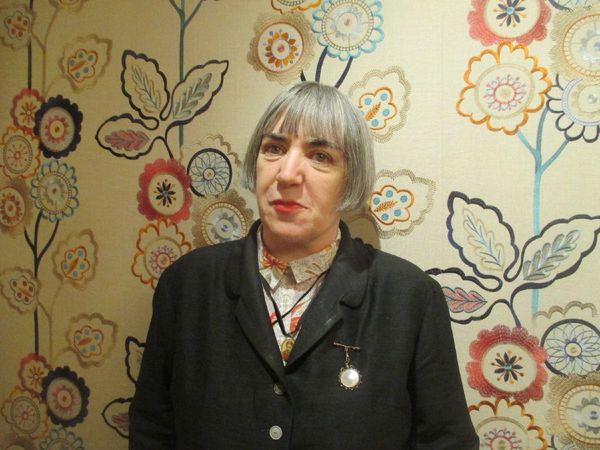 |
| Maudie director Aisling Walsh on Maud Lewis: "She found her freedom in painting." Photo: Anne-Katrin Titze |
In my conversation with Aisling Walsh in New York, we discussed Everett (Ethan Hawke) and Maud Lewis's (Sally Hawkins) house in Maudie, her paintings, being stuck in the Thirties, Kari Matchett as a Katharine Hepburn sounding, Peggy Guggenheim-like character named Sandra, transcending time, and what it means to be labeled a Folk Artist.
The small hovel without running water or electricity (that stands now in a museum in Halifax, Nova Scotia) was Everett and Maud Lewis's home their entire life together. Without having to rely on sentimental escapism, one could say that these "odd socks" make more sense as a couple than much of what is presented as becoming a relationship in most mainstream Hollywood fare.
_225.jpg) |
| Everett (Ethan Hawke) and Maud Lewis (Sally Hawkins) |
Slowly - and Walsh is particularly good with time - their relationship shifts and the hut changes into a compact wonderland of color and delight because Maud discovers painting. Bright and lovely with a logic totally her own, things transform. Sandra (Matchett), a woman on vacation from New York, by a coincidence concerning undelivered fish, discovers the artist and becomes Maud's friend. She, Sandra is the only one in the film whose clothes help us navigate the time period we are in.
The performances under Walsh's direction capture the fine splinters of motivation and the mystery that we all are to each other.
Anne-Katrin Titze: Naïve Art, Folk Art is in a certain sense often anything but naïve. I am thinking of Henry Darger and also Maud's paintings that express a great longing. Is that the connection between her art and her life, the longing? The three cats are fascinating.
Aisling Walsh: I think so. People make the mistake often in thinking that Folk Art is very naïve and they are generally untrained people. And yes, maybe they were but we discovered when we had to break those paintings down to reproduce them for the film how sophisticated they are.
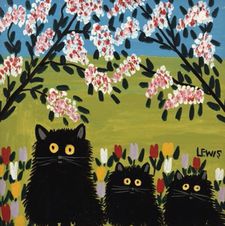 |
| "And if you look at those three cats, they're just beautifully placed in the frame with the flowers around them." |
And if you look at those three cats, they're just beautifully placed in the frame with the flowers around them. Or, if they're in the snow, the snowy trees around them - it's very sophisticated. One can often mistake Folk Art for being rather simplistic and I just think her view of the world is quite fascinating as well.
AKT: Just looking at the cat picture, it speaks of time. There are tulips behind the three cats but then there are cherry blossoms up above. You use that issue in your film as well, that she transcends time. She is working with the seasons and produces a sort of timelessness.
AW: She does. And over the course of her 40 years of painting, that's what she did. She painted a lot of the same things again and again and again - like a lot of artists do. She does transcend time.
AKT: I was struck near the end, in the hospital - suddenly we realise that time has passed.
AW: That's good.
AKT: Because for the longest time, time is circular or rather seems to stand still in that hut, in her life, in her clothes. She is stuck in the Thirties. Why would she buy new clothes?
AW: Yeah. It was something I didn't want people to notice really. I'm so glad you said that. I think when you first realise that time has passed and that she's got very old is the scene where the doctor comes to see her. And shortly after in the hospital you realize that she is an older woman and he is older. Somehow in that little 12' x 12' house time did stand still. Years passed, their life was the same. I'm sure their day started with in the wintertime how to keep themselves warm. They had no electricity and no running water.
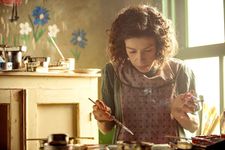 |
| Sally Hawkins as Maud Lewis: "I think she lost herself in her imagination." |
That stove was the centre of their lives. Ethan does it quite a lot in the film - he opens up the door and the first thing he does is he goes to the stove and puts logs on. Their life revolved around that. It was very important to me that time just passed and you didn't notice it. And suddenly you think, oh my god, these people were married for like 40 years. And her paintings are kind of timeless, you know.
AKT: And what she paints is the core of life and nature. I had a conversation about an Italian film called The Confessions with the director Roberto Andò. In his film there is a monk played by Toni Servillo who says "Time doesn't exist, it's only a variable of the soul." That fits perfectly for Maudie and her husband.
AW: Oh, it does.
AKT: The greatest brutality comes from family. Maudie with her brother [Zachary Bennett] and her aunt [Gabrielle Rose] - is that based on her life?
AW: That's true. It's interesting in families there's always one person who maybe suffers more than everybody else because of who they are and what they are. She is the youngest child. She had the beginnings of that disability as a child, juvenile arthritis, she was a little bit of an oddity. Eventually she was homeschooled by her mother because she was bullied and jeered at a lot by the other kids. And she was very well educated.
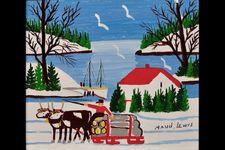 |
| Oxen With Logs - Maud Lewis: "People make the mistake often in thinking that Folk Art is very naïve ..." |
She could play the piano, really rather middle-class life and her parents died within a year of each other when she was in her twenties. And suddenly she was left with nothing. This older brother who's a bit wayward and he disinherited her and sent her to live with that aunt. All of that's true. That changed her life. Suddenly she realised in her late twenties or early thirties that she could have her own life.
AKT: And all the difficulties getting that! All the obstacles! I very much liked how you are showing the all-at-once-ness. When bad things happen they are piling on - which is realistic.
AW: That's what I mean. In families there's one person who carries that burden or that baggage a little bit more than other people. Maybe that made her want that other life so much. I imagine - because I was trained as a painter myself - she lost herself painting and drawing. Some people find it in music or reading.
She found her freedom in painting. It's that classic story of single women of that age in the Thirties and Forties that are slightly different, that are slightly on the edge of what was presumed normal. I think she lost herself in her imagination.
AKT: And the character of Sandra [Kari Matchett] sees that in her.
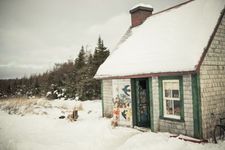 |
| Everett and Maud Lewis home: "Somehow in that little 12' x 12' house time did stand still. Years passed, their life was the same." |
AW: She does, yeah.
AKT: She herself connects to that. Did you have her speak a little bit in the rhythm of Katharine Hepburn?
AW: Yes. She does. To evoke that period of the Thirties. This is a very sophisticated, educated lady coming from New York to holiday there [Nova Scotia] - as a lot of those people did at the time. She has a great interest in art and recognises in a way that somebody like Peggy Guggenheim did. Had it been years later, could you imagine if she brought Maud to New York?
She saw something in her. You got to see these paintings in real life. There's a great beauty and a great vibrancy to them that's so much her character and I think that's what Sandra saw. And Sandra saw something of herself in that work, I think.
Read what Aisling Walsh had to say on working with Sally Hawkins and Ethan Hawke, and choosing costumes for Maudie.
Maudie screens at the Edinburgh International Film Festival later this week and is in cinemas in the US. The film will open theatrically in the UK on August 4.





















